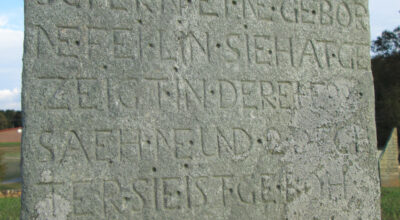Tadpoles and other ‘canned’ things from home
Published 12:00 am Monday, June 16, 2014
I recently watched a documentary about migrating wildebeest crossing a river. Their fording method had some similarity with that used by army ants, except that the “beests’” bridge was drowned and dead, while the ant bridge lived.
This scene of a trampled, watery death took me back to the spring of 1963 when flowers were opening and being pollinated. A good many “pollinated” frog eggs were already hatching, too.
One day, I turned one of my mother’s quart Mason jars (previously occupied by string beans) into a “tadpole aquarium.” I scooped them from a “tadpole nursery” (water-filled ditch along the Old Concord Road). Water always naturally lasted there for the raising of at least one generation.
I fed them some fish food from W.T. Grants, which they seemed to enjoy. Looking back at their fondness for fish flakes and their spawning place, I have my own pet term for them: “road fish.”
After they achieved some size and a few rudimentary legs, I proudly brought my “canned” tadpoles for “show and tell” to Mrs. Overman’s third-grade class at Granite Quarry School.
In those days, little boys often showed up at school with something interesting (usually gross) brought from home in their mothers’ canning jars. The contents more often consisted of a couple of repeated items. One was a praying mantis in a Mason jar chewing off the head of a grasshopper, then working on the “soft stuff” (the mantis’ “prayer” having seemingly been answered, but not so the supplication of its unfortunate prey).
The other item was a snake, having been killed with “great rejoicing throughout the land” (or at least the neighborhood). I wonder if the killing of a snake (even a “good” one) in the yard now, is the great “biblical” sort of event that it was when I was growing up. I have some friends who are still infused with extra “enmity” from above (or somewhere) for those creatures.
In the snake’s case, the canning jar became one of “pickling,” achieved through the use of an entire bottle of rubbing alcohol.
Snakes, so “embalmed,” became ghastly with age, the eyes turning snow white, giving instead of the impression ”cottonmouthed,” the impression, “cotton eyed.” (I am reminded of an old Cajun tune.)
Today, for bug collecting, science museum gift shops sell a “specimen” jar (the nurse hands you the “other” one), but back then, for the purposes of bugs, snakes, tadpoles and sprouting potatoes, Mr. Mason’s jar worked wonderfully.
The class enjoyed my tadpoles. I don’t recall everything said about them, but being school, I’m sure the “M-word” (metamorphosis) was mentioned, and that they wouldn’t remain tadpoles for long.
Bus-loading time arrived, and we headed out the classroom door in rapid single file, like paratroopers on the parachute line. It wasn’t a race (the teachers and Principle C.L. Barnhardt saw to that), but those multiple, quick-paced lines of pupils moving through the hall on those old wooden, sonorous floors made it sound like the rumbling of spooked longhorns.
In the midst of “herd mentality,” the “home-canning aquarium” slipped my grasp, hitting the floor and spilling a stream of water and tadpoles. I managed to scoop some of them back into the jar to prevent their being trampled, but alas, there was a great deal of “pollywog mortality” that afternoon on the old floors of that later-demolished building.
I felt a little in danger of being trampled myself, and similarly so since then on a heavily traveled highway while providing “roadside assistance” to turtles.
If those tadpoles had already become frogs, their fall would have been like a great hop from which they could have kept on hopping, avoiding the army of bus-bound feet, but unfortunately, they hadn’t.
An approximate number of wildebeest perish annually in their migration across swollen streams. An approximate number of lemmings annually hurl themselves into the sea. An approximate number of baby sea turtle hatchlings are annually picked off in their race to the ocean by hungry birds.
All of those amounts are approximations, educated guesses; but there is one thing of which I am absolutely, numerically certain: I know exactly how many tadpoles have ever been trampled to death by excited schoolchildren on their way to load the afternoon bus.


